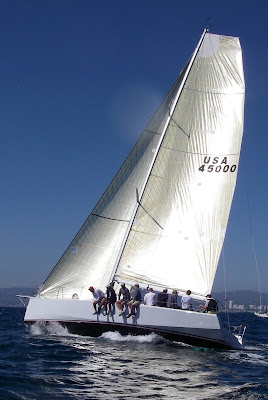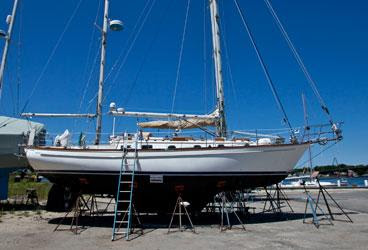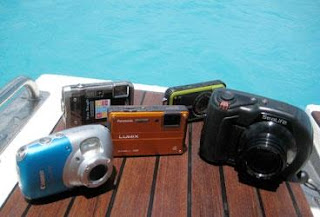
All new designs from Catalina Yachts can trace their pedigrees back to the first boats Frank Butler built in California just as fiberglass-boat building was taking off. The newest, the Catalina 375, is one of them. In coming up with a successor to the legendary Catalina 36, Catalina’s long-time in-house designer, Gerry Douglas, had his work cut out for him. How do you improve on a design that has enjoyed a successful production run of over 25 years? I sailed one on Miami’s Biscayne Bay to find out.
On deck
The 375 builds on Catalina’s reputation for big, comfortable cockpits, easy sailhandling systems, and lots of stowage. The hull lines combine that distinctive Catalina style with a more contemporary look. Cockpit seats are well over 6 feet long, the primary winches are right next to the helm, and the cockpit has sufficient brace points. A large locker under the port cockpit seat provides plenty of room for deck gear. There’s also a dedicated area for installing generator and air-conditioning units. Wide side decks allow for easy access to the foredeck, and inboard shrouds allow for tight sheeting angles upwind. The anchor locker is deep. The lifeline stanchions are sturdy, and the antiskid is just that. Nothing on deck is radical, but everything is well executed.
Under sail
It doesn’t always work out this way, but our test sail on Biscayne Bay was ideal. We had 12 knots of warm Florida breeze, flat water, and lots of time to put the boat through its paces. Unlike many new boats that fly blade jibs and large mains with fat roaches, the 375 flies a conservative in-mast-furling main and an overlapping (135 percent) jib. The benefits of this configuration speak for themselves. Sailhandling is easy, and there’s still plenty of sail-area horsepower. Upwind during our sail, speeds hovered around 6 knots and crept up to the low 7s when I drove for maximum speed in the puffs. We tacked through 85 degrees, and I could have pinched a little higher (and sacrificed a little speed) if I needed to. Tacking the jib requires more winch grinding than a smaller blade jib would, but it’s hardly a problem. On a beam reach we were trucking along in the 7-knot range as easy as you please. The helm was smooth, and so was our motion through the water.
Under power
The 40-horsepower Yanmar diesel, three-blade fixed prop, large rudder, and fin keel all combine to provide precise control under power. Slowing down and backing and pivoting our boat into a slip was as easy as you’d want it to be in a tight marina. Our speed was 7 knots at 2,500 RPM as we motored out to the bay, and fuel consumption, a figure builders are starting to tout in these days of $5/gallon diesel, is about .6 gallon per hour at 2,000 RPM.

Accommodations
Catalina designs always seem to get proportions down below just right. The galley counter top is angled to provide a little extra room for the “chairs” (comfy individual seats with a table between them) that occupy the starboard side of the saloon. The long, straight settee on the port side is plenty long enough to stretch out on, and the large hinged dining table retracts out of the way and is stored on the main bulkhead. The nav station, with a full-sized chart table and dedicated chair, is much more than an afterthought tacked on to the end of the settee. Over all, the saloon space is both airy and inviting. Douglas shares my belief that a forward cabin with a large opening hatch makes an ideal master cabin. The partial walk-around bunk is adult-sized, and there is plenty of stowage in cabinets, a hanging locker, and beneath the bunk. The aft cabin is tighter, but still has enough room for a large double berth (both bunks have innerspring mattresses). And instead of jamming two heads into a boat this size, Douglas wisely opted for one big head (adjacent to the forward cabin) with a large shower stall. The accommodation plan works well, and I’d have no trouble spending a week or more aboard.
PROs:
Wide, forgiving groove upwind
Large comfortable cockpit
CONs:
Some drawer slides stick
The cabintop main sheet requires a singlehander to leave the helm
CONCLUSION
If something has worked well for 25 years, it’s hard to make radical changes to it. The hull lines, basic accommodation plan, and deck layout are all pretty similar to what has come before. Since every aspect of the boat has been scrutinized and incrementally improved, the result is a more “updated” than “new.” This is a no-nonsense cruising design that loyal Catalina owners and new buyers will like.






After just a few weeks, we love it. So much so that we have bought another one (the first one is in charter at http://www.cya.com.au).
A great boat for the family.
It’s a nice event if you’re looking for sailboats for sale. There are many brands that you can choose from like the Vanguard, a Morgan, or a Beneteau. When you are looking for a sailboat you should make sure that it has ample space that you might need before you buy it.